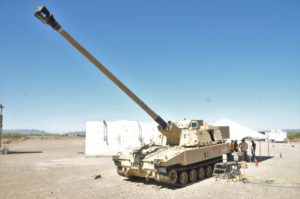The Army has received final proposals from its small business cohort program to find innovative ideas to increase the rate of fire for its future Extended Range Cannon Artillery (ERCA) system, with plans to select five concepts to move forward in the coming weeks.
Brig. Gen. John Rafferty, director of the Long Range Precision Fires Cross Functional Team, said the concepts out of the Fire Faster Cohort will help inform the Army’s decision later this year on a path forward for the ERCA autoloader capability.

“What we saw were incredibly promising technologies that may, in some ways, compliment the autoloader, that may give us an alternative to the government designed autoloader, but either way, give us really good options to make a really hard decision later this year, going into next year,” Rafferty said during a Foundation for Defense of Democracies discussion last week. “I think I’d like to say, we’ve put a chalk mark on the calendar of when we want to make this decision. And we think we’ll be in a position probably at the end of this year where we’ll be able to make the right decision for increasing the rate of fire in the extended range cannon artillery platform.”
The 18-week Fire Faster Cohort, Army Applications Lab-led Special Program Awards for Required Technology Needs included 15 companies in the robotics and autonomy space that offered ideas for “alternative ways to help improve the [ERCA] rate of fire.”
“We’ve got time to get the rate of fire right. And what we learned from our first experience with the Army Applications Lab in this community of innovators was that we don’t have all the good ideas, and if we can break down barriers to small business to doing business with the government, maybe we can crack into this community who – their livelihood is solving hard problems, and we’ve got a lot of those,” Rafferty said.
The five companies with successful proposals will continue to refine their concepts which could support the government-designed ERCA autoloaders which is set to be demonstrated this summer (Defense Daily, Jan. 27).
Brian Beyer, executive vice president of Carnegie Robotics, one of the 15 companies that participated in the cohort, said this week the program offered the company an easier path to working the Army as a potential customer.
“Fire Faster has allowed us to take commercial technology and bring it back to the Army. In the past, a lot of dual-use defense and commercial businesses have used DoD funding as non-dilutive capital for intellectual property development. In this case, we’re able to bring technology back to DoD from commercial areas where the DoD is no longer at the edge of innovation,” Beyer said during the virtual AUSA Global Force Next conference.
ERCA, which involves putting a 58-caliber, 30-foot gun tube on BAE Systems’ M109A7 self-propelled howitzer chassis, is designed to hit targets out to 70 kilometers and the ability to fire six to 10 rounds per minute, with plans for initial fielding in 2023.